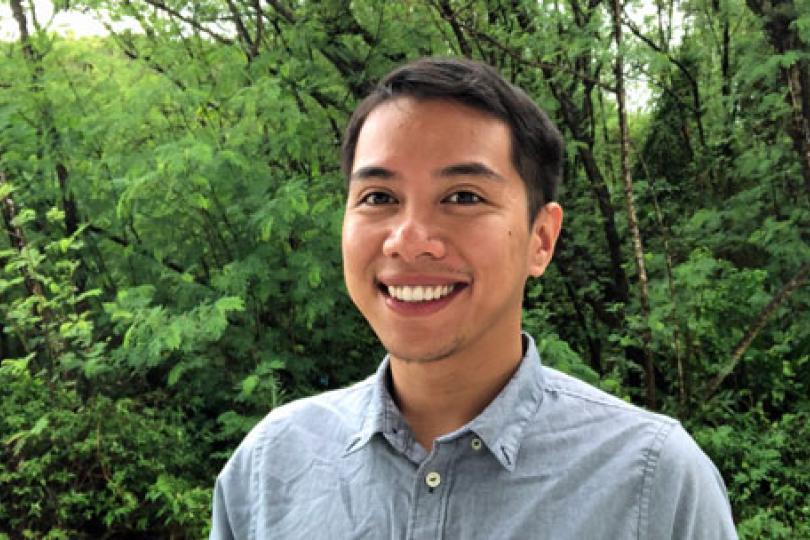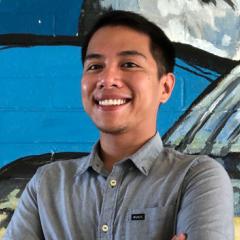“Hiding in plain sight”: Aaron Maruzzo tells the story of PFAS in Saipan
Switzer Fellow Aaron Maruzzo is bringing the leadership and technical skills he learned while pursuing a MPH in Environmental Health Sciences at UC Berkeley back to his community to “reduce pollution and improve environmental and human health through community-based action.”
Aaron, who identifies as Filipino, grew up on the island of Saipan in the Commonwealth of the Northern Mariana Islands (the CNMI) and in southern California. He “witnessed firsthand the real-life health and social effects of systemic violence placed disproportionately on poorer communities of color” across both of these communities. Those experiences instilled a desire to help his community and ultimately led him to a career in public and environmental health.
One of the disproportionate effects Aaron has seen is exposure to per- and polyfluoroalkyl substances (PFAS) — a diverse class of thousands of highly persistent chemicals found across environments. In 2016, the EPA released water monitoring data that showed PFAS were ubiquitous in drinking water systems across the United States and its territories, exposing over 15 million residents. When Aaron, a water analyst in Saipan at the time, dug into the data he saw that Saipan had the maximum concentrations of certain PFAS.
“What struck me the most about this story was how these levels were not addressed at the time they were uncovered — they were hiding in plain sight. Part of my mission is to highlight and develop this story.” Aaron also recognizes that PFAS “contamination in the islands is intricately wrapped up in co-occurring issues: militarism, neocolonialism, and climate change, for instance.”
We interviewed Aaron on the unique professional and personal challenges and opportunities of working to improve environmental and human health at the intersection of these two little-recognized acronyms: PFAS and the CNMI.
“Shedding light on PFAS and the CNMI tends to require a lot of repetition — and a lot of explanation — being forced to justify over and over that they exist, and both matter. Exhaustion is common in environmental advocacy, but I find strength in knowing that the work we do matters. … Words fail to describe how uplifted I feel when I look around and remember that [the Switzer Network] is an entire community of leaders on the quest for environmental justice.”
Read on for the full interview with Aaron, and visit his Switzer Fellow profile here.
Switzer Foundation: What motivated you to pursue your master’s in public health? What have you been working on as part of your studies, and how do you see it influencing your future work?
Aaron Maruzzo: I’ve been passionate about public health since high school, but I didn’t decide on pursuing an MPH in Environmental Health Sciences until I spent two and half years as a water analyst in Saipan. That experience made me realize I needed more leadership and technical skills if I was going to make a bigger impact to improve public and environmental health.
In my graduate program at UC Berkeley, I focus on a class of contaminants called per- and polyfluoroalkyl substances (PFAS), a diverse class of thousands of highly persistent chemicals found across all environmental media. To a large degree, I also focus on telling the story of environmental injustice in Saipan and the Western Pacific Region. And when I graduate, my goal is to leverage the skills I gained to help reduce pollution and improve environmental and human health through community-based action.
Switzer: What led you to your interest in public and environmental health? How did your experiences growing up in the CNMI and CA impact your career path?
Aaron: It’s cliché, but fundamentally, I really just wanted to help my communities. I grew up in many communities across Saipan and southern California, witnessing firsthand the real-life health and social effects of systemic violence placed disproportionately on poorer communities of color. Saipan, for instance, is a predominantly nonwhite community with a large proportion of noncitizen residents and Indigenous Chamorro and Carolinian people. I was interested in the solutions and action to uplift my communities. Public health allowed me to use what I was learning in the classroom and apply it to the community to make a difference.
Switzer: What are some of the water quality problems you encountered at the Water Lab in the CNMI? What do you see as opportunities to address these issues?
Aaron: In 2016, the EPA published national water quality data from public water systems across the United States, including its territories. The data showed that PFAS were ubiquitous in drinking water systems, exposing over 15 million U.S. residents. At the same time, when we look closer at the data, we see that the maximum concentrations of certain PFAS were in Saipan. And what struck me the most about this story was how these levels were not addressed at the time they were uncovered — they were hiding in plain sight. Part of my mission these days is to highlight and develop this story.
One of the opportunities to address PFAS on the islands is to conduct community-based participatory research. It’s a chance for the islands to leverage their own expertise and resources to demonstrate environmental stewardship, contributing to our overall understanding of the distribution of pollution and their impacts on health, while also empowering residents to take action to improve the community’s natural resources and well-being.
Switzer: What has been one of your most rewarding and/or challenging experiences working in water quality and environmental health?
Aaron: The most rewarding thing about this work is knowing that you’re making a difference in the community and the environment at the same time. Personally, I also really enjoy bringing people together and identifying different levers in the system to support community health and to empower others. For instance, I’ve organized a public comment letter among UC Berkeley students and a CNMI nonprofit on a bill aiming to address PFAS. In 2021, I facilitated conversations about PFAS risks among Guam stakeholders in science and policy. I also had the opportunity to work with the National Academies of Sciences as a community liaison, representing the CNMI and advocating for a justice-focused lens to addressing PFAS. And, perhaps most importantly, I’m particularly proud of the work I did when I was a Water Lab Analyst for the public water system, going beyond my work duties to get people talking about water quality.
Getting a bit more personal, one of the biggest challenges I’m confronting these days in environmental health on this side of the Pacific is the loneliness and isolation I feel sometimes working on these issues. I tend to focus on the intersection of PFAS and the CNMI, two acronyms that many people are unlikely to recognize. Shedding light on PFAS and the CNMI tends to require a lot of repetition — and a lot of explanation — being forced to justify over and over that they exist, and both matter. Exhaustion is common in environmental advocacy, but I find strength in knowing that the work we do matters.
Switzer: Can you tell us about the school outreach program you organized while at the Water Lab, and what inspired you to start it?
Aaron: In 2018, there was a Category 5 typhoon that hit the Northern Mariana Islands and the Philippines called Typhoon Yutu. Part of the response to the damages to the water infrastructure was an influx of water quality supplies. When the dust settled in 2019-2020, we had excess lab supplies that were on their way to waste, and I had an idea of turning those supplies into an opportunity for Saipan’s schools.
Engaging with the community is important to me, and I envisioned a chance to get the Water Lab staff to demonstrate their knowledge and skills in the lab to inform and inspire students. It was a chance to repurpose resources to support STEM education in the local community! Each time we went out to a classroom, we gave tailored grade-level presentations about water quality, discussed the community’s water resources, taught them how to sample water, and put those excess resources to good use!
Switzer: Is there anything you’d like to share about the impact the Switzer Fellowship has had on you this year?
Aaron: The Switzer Fellowship allowed me to connect with so many inspiring people! Even in the limited opportunities we have to share virtually, I get blown away by the insights and stories that my cohort shares. It’s downright inspiring and humbling, to say the least, and I have to pinch myself that I get the privilege to be part of the crew.
Recently, I had an opportunity to work with Switzer Fellow Asa Bradman (Fellow ‘97), professor at UC Merced, on my final project for my graduate degree. And through the Switzer network, I also connected with Angelo Villagomez, a senior fellow at American Center for Progress, who is from Saipan! Connecting with these mentors helped me intellectually and emotionally. Words fail to describe how uplifted I feel when I look around and remember that there is an entire community of leaders on the quest for environmental justice.

